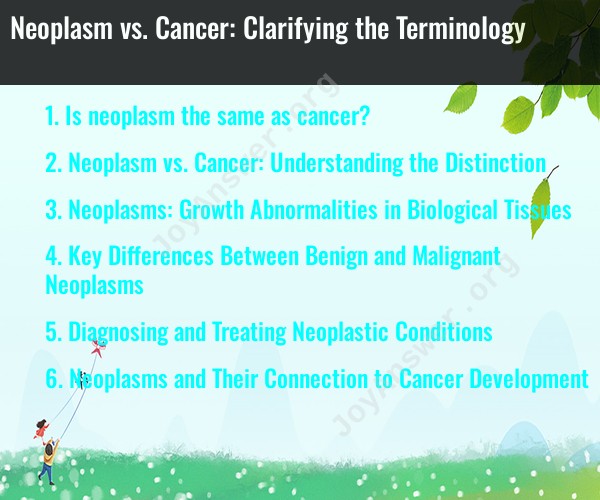Is neoplasm the same as cancer?
No, neoplasm and cancer are not the same, although they are related medical terms. Here's the distinction between the two:
Neoplasm:
- A neoplasm is a broad medical term that refers to an abnormal and excessive growth of cells in the body.
- Neoplasms can be benign (non-cancerous) or malignant (cancerous).
- Benign neoplasms do not invade nearby tissues or spread to other parts of the body. They tend to grow slowly and are often less harmful.
- Malignant neoplasms, on the other hand, are cancerous. They have the potential to invade nearby tissues and can metastasize, meaning they can spread to other parts of the body.
Cancer:
- Cancer is a specific type of malignant neoplasm.
- It is characterized by uncontrolled cell growth, invasion of nearby tissues, and the ability to spread to other parts of the body (metastasis).
- Cancer is a complex disease with many different types, such as breast cancer, lung cancer, and prostate cancer, each with its own characteristics and treatment approaches.
In summary, while all cancers are considered malignant neoplasms, not all neoplasms are cancer. Neoplasms can include both benign and malignant growths, but the term "cancer" specifically refers to malignant neoplasms with the potential for aggressive growth and metastasis. The distinction is important because the management and treatment of benign and malignant neoplasms, including cancer, are different.
Neoplasm vs. Cancer: Understanding the Distinction
The terms "neoplasm" and "cancer" are often used interchangeably, but they have distinct meanings. A neoplasm is a new and abnormal growth of tissue. It can be benign (non-cancerous) or malignant (cancerous). Cancer is a specific type of neoplasm that is characterized by uncontrolled cell growth and the ability to spread to other parts of the body.
Neoplasms: Growth Abnormalities in Biological Tissues
Neoplasms can arise in any type of tissue in the body. They are caused by a variety of factors, including genetic mutations, environmental toxins, and chronic inflammation.
Benign neoplasms are typically slow-growing and do not spread to other parts of the body. They may cause symptoms, such as pain, swelling, or pressure, but they are rarely life-threatening.
Malignant neoplasms, on the other hand, are fast-growing and can spread to other parts of the body through the lymphatic system or bloodstream. This process is known as metastasis. Metastasis is what makes cancer so dangerous.
Key Differences Between Benign and Malignant Neoplasms
The following table summarizes the key differences between benign and malignant neoplasms:
| Characteristic | Benign Neoplasm | Malignant Neoplasm |
|---|---|---|
| Growth rate | Slow | Fast |
| Ability to spread | No | Yes |
| Impact on surrounding tissues | Pushes aside surrounding tissues | Infiltrates and damages surrounding tissues |
| Risk of metastasis | Low | High |
| Risk to life | Low | High |
Diagnosing and Treating Neoplastic Conditions
Neoplasms are typically diagnosed through imaging tests, such as X-rays, CT scans, and MRIs. Biopsies may also be performed to obtain a sample of tissue for further examination under a microscope.
Treatment for neoplasms depends on the type of neoplasm, its location, and its size. Benign neoplasms may not require treatment, or they may be removed surgically. Malignant neoplasms are typically treated with surgery, radiation therapy, chemotherapy, or a combination of these therapies.
Neoplasms and Their Connection to Cancer Development
Not all neoplasms develop into cancer, but the risk of cancer increases with the presence of certain types of neoplasms. For example, precancerous lesions are a type of neoplasm that is at high risk of developing into cancer.
Precancerous lesions can be identified through screening tests and treated early to prevent cancer from developing.
Conclusion
Neoplasms are abnormal growths of tissue that can be benign (non-cancerous) or malignant (cancerous). Malignant neoplasms, also known as cancer, are characterized by uncontrolled cell growth and the ability to spread to other parts of the body.
Early detection and treatment of neoplasms is essential for improving outcomes. If you have any concerns about a neoplasm, please consult with your doctor.












